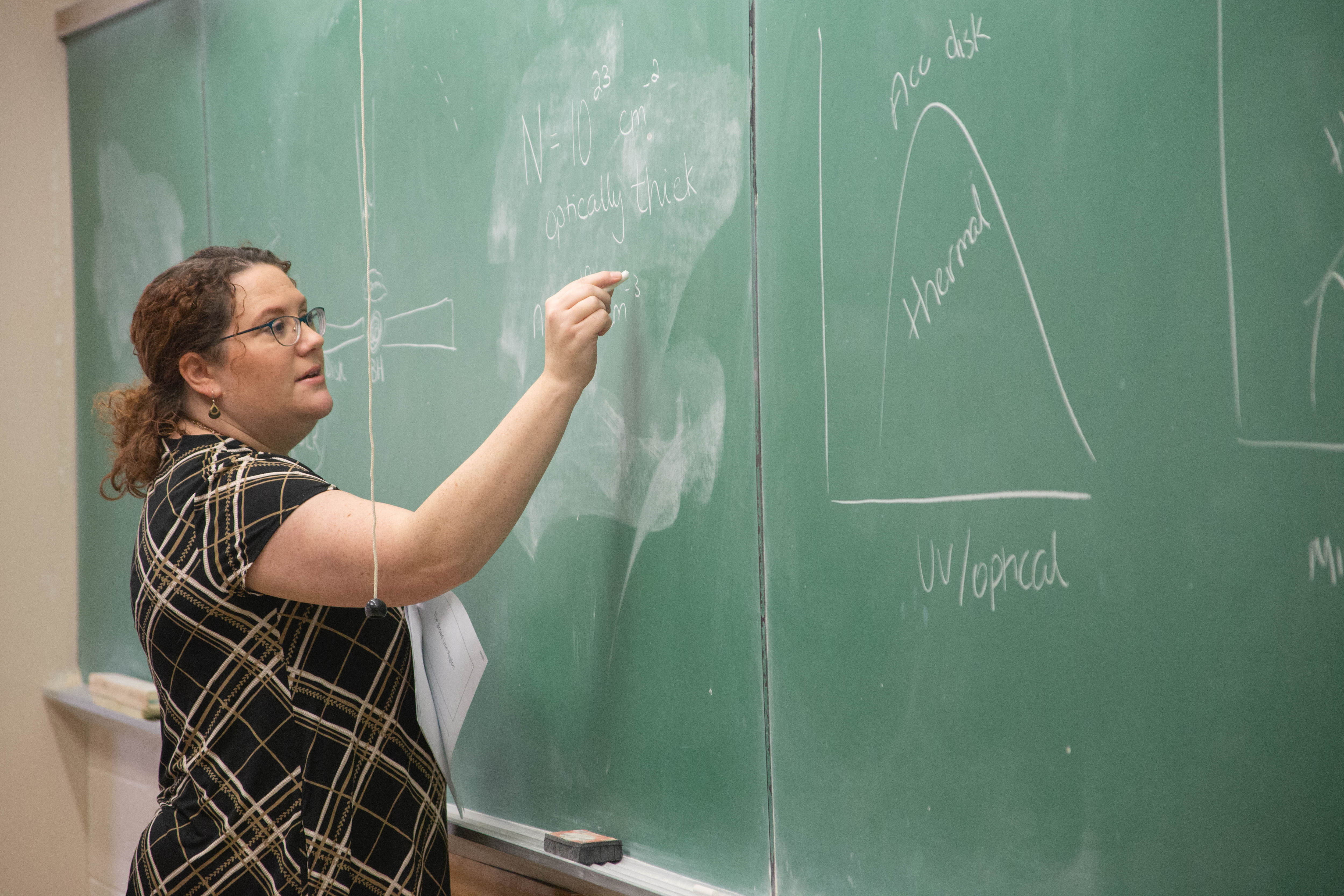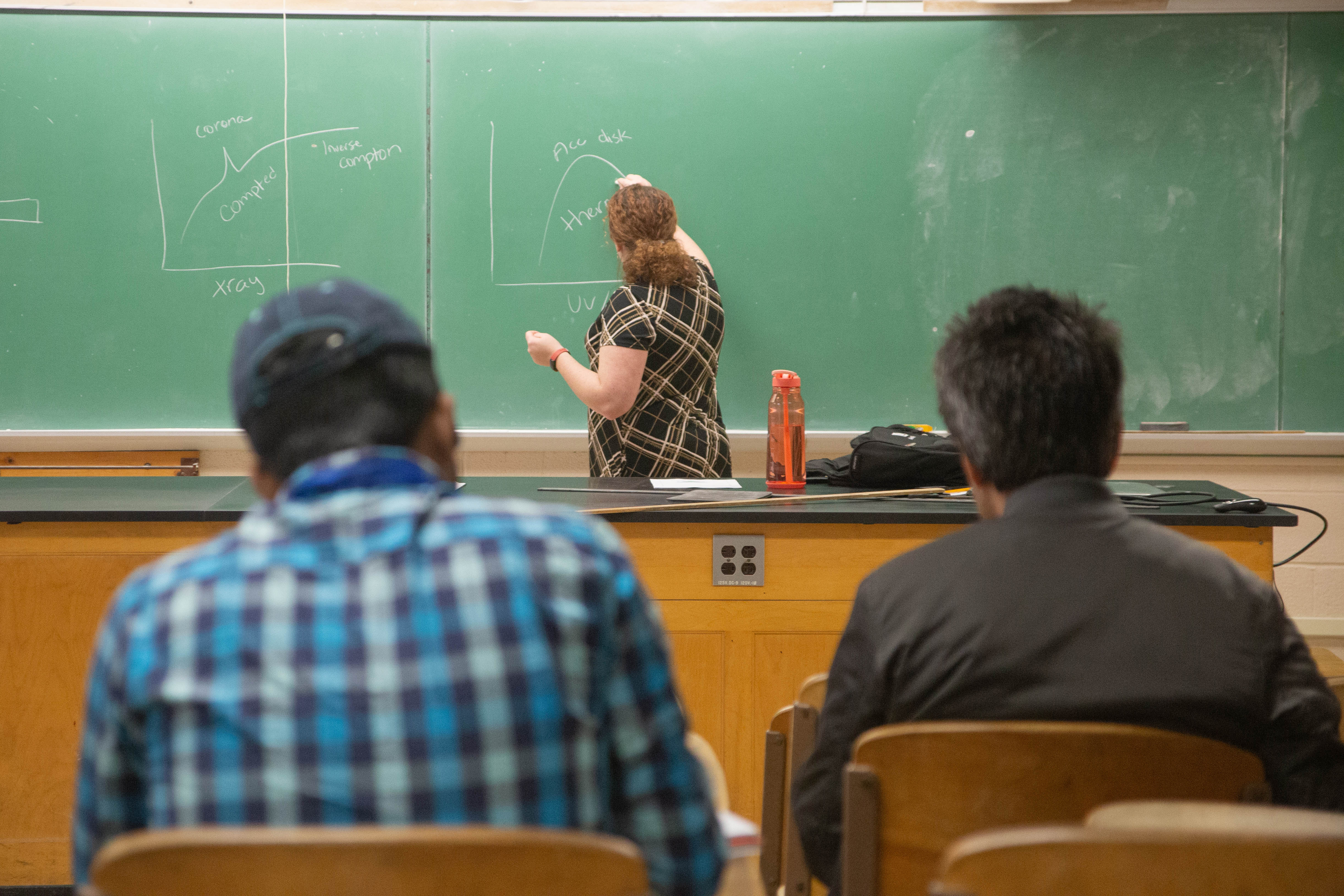‘I am striving to inspire the next generation of women to uncover the mysteries of the universe’
The video contains select images and video clips from NASA, ESA, S. Beckwith (STScI) and the HUDF Team, M. Viero, Michelle Vigeant.
University of Kansas faculty are striving to advance knowledge, interpret our world, solve problems, spark innovation, create beauty and catalyze imagination through their research, scholarship and creative activity. Through the “I Am Striving” series, we’ll learn more about what inspires KU researchers, as well as the goals and impact of their work.
Q&A with Allison Kirkpatrick, assistant professor of physics and astronomy
Explain your research as you would explain it to someone, say your grandparents.
The Milky Way is one galaxy out of hundreds of billions of galaxies in the universe. Every galaxy has a supermassive black hole in it. Our supermassive black hole happens to be a million times the mass of the sun. A few of the open questions in astronomy are, “How did these supermassive black holes form?” “How did they grow?” and “Are they impacting the galaxy around them?” Right now, my research mainly concerns that last question, although with our incoming data from the James Webb Space Telescope that launched in December, I will start to examine the first question.
What does your research look like? What kind of methods do you use?
I spend a large part of my time writing proposals to get time on space telescopes, which is where most of my data comes from. I have a lot of data coming up from the James Webb Space Telescope. We get these beautiful images, and then it’s our job to analyze them. I measure the brightness of a galaxy and compare brightness at different wavelengths, which can tell us about how fast the black hole is growing. I also use multi-wavelength data from galaxies to measure certain properties, such as how massive these galaxies are, or how many new stars they're forming, because the supermassive black hole can also affect that. I also use spectroscopy, which takes an incoming beam of light and spreads it out into all the different wavelengths. Spectroscopy is a really cool technique because you will see certain fingerprints of the gases that are surrounding the object you're looking at. For a black hole, we'll see all the gas near the black hole. This can tell us how fast the gas is moving in relation to the black hole, and essentially, how fast the black hole is growing.

What inspires your research? Why are you passionate about this work?
There's just so much we don't know about the universe, and we're not going to know it even in my lifetime. There are always new questions. It’s fascinating to read papers from 10 years ago that I learned in graduate school that have now been evolving. We have a different conception of the universe than we had even 10 years ago. I get to play a really small part in helping humanity figure out this great environment in which we live.
How does your research directly impact your field, society, and the world?
Number one, the fact of being human means that we are aware of ourselves. We're aware of our own mortality, and we're aware of our surroundings in a way that other animals are not. I get to help answer the mystery of, “How did our galaxy get here?” And not only that, but what is the fate of humanity as it resides in our galaxy? What's going to happen to our galaxy in the future? I get to play a role in helping humans understand ourselves. Also, everyone loves space, so the second role that I get to play regards society. It's a great science to get people interested in science. Everyone can do science. Science is for everyone. I like to do the things I do to inspire people to explore more science and possibly consider majoring in STEM. We always need STEM majors. As a female scientist, there aren't very many of us. I like to reach out to women, people of color and non-binary students — all the people that aren't typically represented — and make sure that they understand that science is for them too and that they belong here.

What is a recent study/example of work you’d like to share?
Since I've been at KU, I've found this unique population of galaxies that I have coined, “cold quasars.” Typically, you find a massive actively growing black hole in a quasar. That's the term for the galaxy they live in that don't have any ongoing star formation. That quasar has already entered its end-of-life stage. Because once a galaxy stops forming stars, that's it for it. I have recently found a rare population — it seems to be about 5% of the quasar population — that has very high star formation rates. These are galaxies that are forming 100 to 1000 new stars a year. For perspective, the Milky Way is only forming one star year. So, this is really weird. It's not explained by any current picture of galaxy evolution. I have been trying to untangle this picture of galaxy evolution. This is an area in which many of my students are active. They’ve measured the shape of these galaxies, characterized the dust in them, and found these quasars have more star formation than previously thought. This is all challenging the current picture of galaxy evolution.
What do you hope are some of the outcomes of your research and work?
Nobel Prize? No, I'm very modest in what I hope the outcomes are. I hope I have a long-lasting career. I hope that all my students go on to do well in science. I hope that I can contribute something meaningful to the field. I hope that my work gets recognized and furthers our understanding of how galaxies evolve and what may happen to the Milky Way one day.
First photo: Allison Kirkpatrick, assistant professor of physics and astronomy, next to an image of a cold quasar. Credit: NASA.
Second photo: Allison Kirkpatrick draws examples on a chalkboard at the front of a graduate-level astronomy and physics class on supermassive black holes.
Third photo: Allison Kirkpatrick teaches at the front of a graduate-level astronomy and physics class on supermassive black holes.